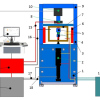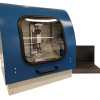Analyzer of accelerated material aging, especially mechanically and thermally stressed vulcanized rubber
Technology description
| The name of the technology: | Analyzer of accelerated material aging, especially mechanically and thermally stressed vulcanized rubber |
|---|---|
| Challenge: | In the development of rubber components and products, many conflicting properties must be balanced through design, material selection, complex physical property requirements and, in particular, dynamic-mechanical and thermal behaviour. Therefore, one of the most important requirements for vulcanised rubber is long-term heat resistance, which limits the rubber's susceptibility to thermal ageing leading to rubber degradation. Predictions of rubber thermal ageing can be made experimentally under laboratory conditions on samples or directly in the field on real products. Field characterization is both time and cost consuming, whereas current laboratory analyses greatly reduce the cost but not the time required. Therefore, it was necessary to develop and market a laboratory device that is capable of analyzing samples in a very short time to obtain a description of the effect of thermal behavior on rubber degradation, which is the essence of this presented solution. |
| Description: |
Existing methods to analyse the effect of thermal degradation of rubber are based several different analyses, where it is first necessary to apply a thermal effect for a defined period of time to a rubber sample in an insulated chamber and then to determine separatelly the change in mechanical properties compared to a non-thermally affected sample. Therefore, the change in mechanical properties is determined for a given time and value of applied temperature only. Moreover, this is an indirect method, where the determination of the change in mechanical properties is made only after the temperature exposure process has been completed and it is not possible to capture the kinetics of the actual change process as a function of time. To determine the effect of thermal ageing over a wider temperature range, this procedure is both time consuming (weeks to months) and costly. The advantage of the presented new solution is that this method is direct, where the effect of a wide temperature range on the kinetics of mechanical property change is analyzed in a single test rig in a very short time (about 2 hours) and without further follow-up analyses. Another advantage of this solution is that the ageing process is not limited by the temperature range at which the rubber cracks due to temperature are not formed. For at the temperatures at which cracks in the rubber are formed, which is an inherent consequence of the rubber aging process, liquid components of the compound are expelled from the rubber matrix, which, when simultaneously subjected to the higher temperatures in the chamber, adhere permanently to the walls of the chamber and the elements contained therein, thereby rendering the chamber and the individual elements useless for further use. In the case of rubber, these threshold temperatures vary and are dependent on the overall formulation, but the safe temperature level at which crack formation is minimised is in the region of temperatures below 100°C. Given the operating temperatures of rubber products, which very often exceed these values, this application range is unsuitable for standard equipment, and this proposed engineering solution takes this into account and a temperature range up to complete rubber destruction can be implemented, where this varies for different rubbers but is in the range 200 - 300°C. Last but not least, this technical solution allows to apply different loads to the sample, both quasi-static and cyclic fatigue, which in combination with the controlled application of temperature rise provides the possibility to simulate the actual loading of the product in practice and thus obtain very effectively accurate predictive data on the future development of the change in mechanical properties of the rubber under long-term exposure to temperature. |
| Commercial opportunity: |
The accelerated material aging analyzer, especially for mechanically and thermally stressed vulcanized rubber, according to the technical design, is applicable in the rubber industry, especially for the analysis of rubber components in cyclically dynamically loaded technical components of tires, but also in other products such as seals, shock absorbers, power blocks, belts, conveyor belts, hoses and other rubber products. The characteristics obtained in a very short period of time, on the order of hours, are used to assess the resistance of vulcanised rubber compounds to combined mechanical and thermal, and possibly chemical, ageing. The technical solution offers a very wide scientific potential not only for industry but also for research institutions when in a very short time it is possible to determine the influence of individual raw materials of the rubber compound on the change of mechanical properties under the influence of temperature. |
| IP protection status: | Utility model CZ 36767 |
| Development status: |
Phase 2Corresponds with TRL 3 and TRL 4 Feasibility study. There is a realistic design of the technology and the initial tests in the laboratory are leading to the specification of the technology requirements and its capabilities.
|
| Partnering strategy: | Collaboration licensing |
| More information: | |
| Images: | |
| Categories: | Chemical and bioengineering |
| Owner of a technology: | Univerzita Tomáše Bati ve Zlíně |


